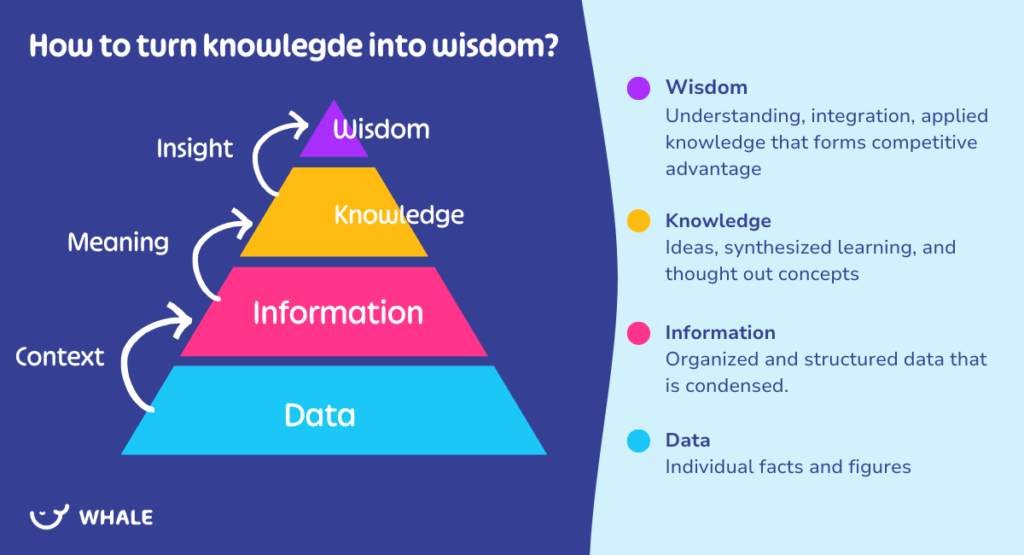What do you mean knowledge management for 101? 🤔 We wanted to take a complex concept and make it easy to understand. It’s a mission we love and have adopted in the way we share information.
So, if you’re new to the idea of knowledge management (KM) and knowledge sharing, then it’s likely that you still have many questions about what this process entails and how to get started with it in your organization.
In this blog, we’ll try to cover some of the basics of knowledge management. We’ll explain what it is and why it’s important, and a few knowledge Management best practices and knowledge-sharing techniques that can be utilized in your organization today.
Knowledge management 101
Knowledge management is the process of collecting, organizing, sharing and storing company knowledge for the purpose of creating more value. The term "knowledge management" was coined by Dr. David Kelly at the Xerox Corporation in 1988. (and Xerox must’ve done something right to stick around for 116 years!)
It’s all about company knowledge becoming a sustainable and useful resource, centralized and organized in one place. Instead of just a ton of information that sits in different places that some people use and others don’t.
Simply put, knowledge management in all its forms provides the tools and framework to help companies leverage their intellectual capital as a critical competitive asset. (You should definitely check out our blog on that!)
Virtually every organization has intellectual capital and needs a Knowledge Management practice. However, not every organization has an established strategy or even understands what KM can offer.
In fact, many organizations are unaware of the existence of knowledge management systems and processes, and how to leverage them to produce organizational wisdom.
So let’s begin with the basics…
Knowledge as an asset
Knowledge is a company’s most valuable asset. And in the new economy, it’s an essential ingredient for success. The era of the knowledge worker has taken hold and there are no signs that it will be relinquished anytime soon. In fact, the movement toward knowledge-based organizations is accelerating as technology makes information more accessible than ever before.
Knowledge management is crucial to business success in the 21st century since it allows you to collect and utilize organizational knowledge in a way that both leverages employee expertise and ensures consistency across boundaries.
It’s all about leveraging collective intelligence for the increased value of the organization.
What are the 3 types of company knowledge?
There are three kinds of knowledge that your company holds.
Explicit knowledge
Explicit knowledge is knowledge that is easy to document and share. It’s what you see in a book or manual or on a website. It’s the kind of information that can be written down and easily shared.
Explicit knowledge includes things like policies and procedures, job descriptions, financial reports and other documents that are stored in hard copy form or electronically on servers or databases.
Implicit knowledge (aka applied or reflexive knowledge)
Implicit knowledge is what employees possess by virtue of their experience working for your company—it’s tacit (not easily expressed) and it usually isn’t documented anywhere. Implicit knowledge comes from years of training at work: how one person does their job may not be applicable to another person doing the same thing elsewhere in your organization because they have different methods for solving problems based on their particular expertise or inherent skillset.
One way to think about it is when someone is performing tasks; they are displaying implicit knowledge, such as performing effective communication. The individual is probably not even aware that they have acquired or are aquiring these skills.
Tacit knowledge
Tacit knowledge is knowledge gained from personal experience.
It is an unrecorded, hidden, and unstated huge depository of knowledge, which is possessed by every person. Tacit knowledge refers to an individual’s experience with something over time; it refers specifically to one’s awareness about how something works without being able to fully articulate why it works correctly (or incorrectly).
These types of insights become ingrained into one’s psyche through repetitive experiences over time; however, they often aren’t apparent when explaining how something functions because they’re not always accessible through conscious thought processes alone—they require specific experience before they become second nature.
What are the benefits of knowledge management in an organization?
There are many reasons why you need knowledge management in your organization BUT the bottom line is it’s all about value!
The obvious reason is to omit risk in organizational change. With people changing jobs more frequently and the use of technology that promotes work flexibility, businesses are increasingly finding it difficult to find enough staff members who are qualified or want to fill certain positions.
Other benefits include;
- Faster onboarding time with new hires
- Creating consistency across the organization
- Promoting innovation within the organization
- Increasing customer satisfaction and experience
- Reducing costs by reducing rework and mistakes made
- Decreasing decision-making fatigue and employee burnout
- Increasing company valuation in exits or mergers and acquisitions
- It allows organizations to share ideas across departments (operations or sales) which means that they can think out of the box when solving problems related to production/sales/marketing etc., instead of just focusing on one area only
Basically, knowledge management is a fast track to unlocking the next level of growth in your business.
Now, who wouldn’t be interested in that?! So how to do it?
3 Tips for your knowledge management process
Most people get instantly excited to talk about knowledge management and the benefits but when it comes down to doing it, it’s instantly overwhelming.
It’s just too overwhelming, right?
Wrong! ❌
It doesn’t have to be and if you follow these simple suggestions then you’ll find you could have everything you need documented and more importantly shared in less than a month!
Before you EVEN start on the steps below, adjust your mindset and remember that process is a business enabler. If you approach it from that perspective, rather than a huge pain in the a** job that has to get done, you’re going to win!
1. Gathering knowledge following the 20/80 rule
Gathering knowledge involves identifying all current and potential knowledge in your business. You’ll also need to identify subject matter experts who can take ownership of sharing content in the form of shareable content.
EOS recommends following the 80 – 20 rule when documenting your core processes; documenting 20% produces 80% of the results.
We agree, and we hear this feedback from past clients time and time again;
💡 TOP TIP – “Pick your top processes and then document them in a fun and engaging way that won’t take a lot of time. Consider using alternative methods like video and infographics.
2. Storing knowledge in a central repository
Storing knowledge is the start of the magic and making knowledge management a vital asset in the business.
This brings us knowledge management systems! And UBER systems like Whale.
Storing knowledge in an easy-to-use central source of truth — so you can onboard, train, and get everyone on the same page.
💡 TOP TIP – “Make content engaging and easy to use using rich media, infographics, video, and even importing Miro charts!”
3. Sharing knowledge across time and space
Source – G2
Okay so you’ve identified all your company processes. You’ve even created fabulously engaging content with graphics, emojis and videos.
Now you store it all in one place so your team members can go find it?
Wrong! ❌
This is where most knowledge management processes fail.
Sharing is not only caring but sharing company knowledge is essential for knowledge sharing to actually work! This is why just having everything on Google Drive isn’t enough.
💡 TOP TIP – “Make sure to utilize a system to leverage knowledge across the organization”.
How to manage company knowledge?
Knowledge Management evolves around 3 primary spheres which are closely integrated: processes, people, and technology.
We alluded to these considerations above but let’s take a moment to understand why these are so important.
1. Use Knowledge Management Processes
KM Processes include standard processes for knowledge contribution, content management, retrieval. Bottom line, how is knowlege management going to happen as a standardized process?
The biggest trick is to systemize the process. For instance setting a constant cadence for content creation and management and making the actual process of knowledge contribution easy.
This cannot happen without people and technology which is why these three aspects are integrated.
💡 TOP TIP – Every time a new hire is onboarded, get the hiring manager to create any documentation or processes that are missing. Then set up quarterly or mid year reviews. With Whale you can do this with automation. This is how knowledge management becomes systemized.
Check out how Kidwell commenced knowledge management and sharing in their business
2. Utilize people in your team
Just like it takes a village to raise a child (African proverb), it takes a team to get knowledge management and sharing right!
Appointing knowledge or subject experts will go a long way to keeping information up to date and relevant within the organization and actually being used.
Some people may be reluctant to share their knowledge as they may see it as a perceived threat to their job security but actually the more an individual is able to share, the more they are freed up to become more creative and innovative in their roles.
💡 TOP TIP – When thinking knowledge management think knowledge sharing to embed processes and continuous learning as a part of culture.
3. Consider technology and knowledge management systems
Knowledge management technology and systems don’t just provide a secure central space where team members access and share knowledge. Technology is fundamental in ensuring that this happens automatically thereby reducing time spent looking for information.
Ultimately the utilization of technology will guide the organization to better decision making through having statistics on hand about what information is being used and what’s missing.
💡 TOP TIP – Here’s how to choose the right knowledge management software for your team.
Here are a few considerations for adopting a knowledge management system.
Does the technology;
- Help get you started and offer support?
- Have reputable success within other organizations?
- Enable knowledge sharing across the organization in real time?
- Enable you to measure the effectiveness and use of knowledge?
- Enable you to continuously improve on knowledge utilisation within the organization
Knowledge management systems (KMSs) are tools that help companies manage their knowledge. Using the right technology can not only help you create the best content, train your teams faster and measure the results BUT it can also going a long way to creating a culture of innovation and facilitate operational efficiency and excellence.
How to cultivate wisdom in a business? 🧙♂️
You’re on a journey to the knowledge pinnacle.
Your goal? To become the most powerful Knowledge Wizard this side of Oz!
You can’t become a wizard or master your craft until you have the basics in place. To put this into business speak – you won’t be able to utilize company knowledge as a competitive asset until you’ve created a knowledge management process within your organization.

Knowledge accumulates over time, shaped through daily decisions and ways of working. As such over time knowledge translates into wisdom to yield a competitive advantage.
FAQs about knowledge management
What is the first step in knowledge management?
Creating a knowledge management plan doesn’t have to be overly complex, especially if you’re focused on getting results without getting bogged down. Here’s a straightforward approach:
-
Conduct a Knowledge Audit: Quickly figure out what key knowledge you already have, what’s missing, and what’s no longer needed. This involves looking at documents, databases, and tapping into the expertise of your team.
-
Define Key Knowledge Areas: Focus on the critical areas of knowledge that drive your business forward. This could be technical know-how, customer insights, or industry research.
-
Choose Tools and Processes: Decide on the simplest tools and processes that will help you capture, store, share, and manage your knowledge. This could be a shared drive, a simple database, or a cloud-based knowledge management system, depending on your needs and budget.
-
Set Up a Sharing Culture: Encourage your team to share their knowledge by making it easy and rewarding. Recognize contributions and ensure that everyone knows how important their knowledge is to the company’s success.
-
Implement and Train: Put your plan into action and train your team on the tools and processes you’ve chosen. Make sure everyone knows how to contribute and access the knowledge they need.
-
Review and Improve: Set up regular check-ins to see how things are going. What’s working well? What’s not? Use this feedback to tweak your plan and tools as needed.
Keep it lean and focused on what’s most important to your business. As your company grows and evolves, your knowledge management plan can grow and change with it.
How do you create a knowledge management plan?
It will depend on the SOP you’re creating but the essential components include;
- SOP Title / Name
- Purpose description
- The scope I.e. what it covers
- Procedures or steps of how to complete the activity
Here are additional guidelines on how to write and format your SOPs.
What is a knowledge management strategy?
A knowledge management strategy is a game plan for how a company handles all the important information and knowledge it has. This strategy encompasses the processes, technologies, and culture needed to capture, manage, and share knowledge within the organization.
The result is improved business processes, enhanced innovation, continuous improvement and a competitive advantage over competitors.
What is an example of a knowledge management strategy?
To give you a working example, our knowledge management strategy at Whale regarding product development has been curated over time.
Now we have best practices for how we launch products and these best practices are located in a centralized database where all technical documentation is stores. This database is accessible to all product and engineering team members, allowing them to quickly find the information they need to solve customer issues.
Key Terms & Further Reading on lnowledge management
Related blog posts
Bottom line?
Knowledge management is a strategic process that helps organizations get the most out of their knowledge capital. It ensures that all knowledge is captured, preserved and available for use.
When used properly, knowledge management can improve decision-making, increase employee productivity and reduce costs.
Our top 5 steps to mastering knowledge management in your organization
- Shift your mindset! Remember process is in your DNA and will actually help your business grow AND will allow you and your team to have more work-life balance, not less!
- Discover the 80-20 knowledge areas within your organization and start there! Remember to appoint company experts so it becomes a company-wide exercise.
- Find a system which supports you! Really really. We’re not just saying this because we want you to adopt Whale. We suggest doing your homework on the right technology for you but the right KMS is going to offer you support and enable you to create, train and measure the effectiveness of knowledge management.
- Create and share killer content
- Set a review process

Readiness to Scale Assessment
Almost everyone wants to scale their business but where to start? Take our Readiness to Scale Assessment to find out! You’ll be presented with 10 statements that correlate to one of three specific scaling stages in business.







